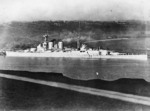Hood
| Country | United Kingdom |
| Ship Class | Admiral-class Battlecruiser |
| Builder | John Brown & Company, Scotland, United Kingdom |
| Laid Down | 1 Sep 1916 |
| Launched | 22 Aug 1918 |
| Commissioned | 15 May 1920 |
| Sunk | 24 May 1941 |
| Displacement | 48,350 tons standard |
| Length | 860 feet |
| Beam | 104 feet |
| Draft | 32 feet |
| Machinery | 24 Yarrow water-tube boilers, Brown-Curtis geared steam turbines, four shafts |
| Power Output | 144,000 shaft horsepower |
| Speed | 29 knots |
| Range | 5,332nm at 20 knots |
| Crew | 1,418 |
| Armament | 4x2x15in/381mm guns, 7x2x102mm QF 4in Mk XVI AA guns, 3x8x40mm QF 2-pdr AA guns, 5x4x12.7mm Vickers machine guns, 4x533mm torpedo tubes, 5 projectile mounts |
| Armor | 152-305mm belt, 19-76mm deck, 127-305mm barbettes, 279-381mm turrets, 229-279mm conning tower, 102-127mm bulkheads |
| Aircraft | 1 (1931-1932 only) |
Contributor: C. Peter Chen
ww2dbaseHMS Hood, a 42,100-ton battlecruiser built at Clydebank, Scotland, was completed in March 1920. For more than two decades, she was the World's largest warship and, with her long, low hull and finely balanced silhouette, was to many the embodiment of "big-gun" era seapower. During her travels in European waters and far away, Hood actively represented Great Britain throughout her career. Her first cruise, in 1920, was to Scandanavia. The next year she went down to Gibraltar and Spain and in 1922 visited Brazil and the West Indies. After a brief call on Denmark and Norway in 1923, Hood was flagship on a eleven-month cruise around the World, accompanied by the smaller battlecruiser Repulse and a number of light cruisers. In 1925, she called on Lisbon to help commemorate Portugal's contributions to navigation and exploration.
ww2dbaseFor ten years after 1925, Hood was assigned to the Royal Navy's Home and Atlantic Fleets, operating primarily around Europe, with a visit to the West Indies in 1932. She served with the Mediterranean Fleet in 1936-39, protecting British interests during the Spanish Civil War. Back with the Home Fleet after mid-1939, Hood operated in the North Atlantic and North Sea through the first part of World War II and received minor damage in a German air attack on 26 September 1939, an event that demonstrated the relative ineffectiveness of contemporary anti-aircraft gunfire. In June and July 1940, the battlecruiser was in the Mediterranean area. She was flagship during the 3 July Mers-el-Kebir battle, the most dramatic and destructive of several incidents in which the British Navy seized, interned, destroyed or attempted to destroy the warships of their recent ally, France. These acts were undertaken on Government orders to allay fears that the French Navy might fall into German hands.
ww2dbaseHood spent the remainder of her service operating from Scapa Flow, covering the North Sea and Atlantic from the threat of German surface raiders. She was now elderly, overloaded, and burdened with an inadequate armoring arrangement. However, her great operational value had acted through the 1930s to prevent the Royal Navy from taking her out of service for a badly-needed modernization, and now it was too late. In May 1941, in company with the new battleship Prince of Wales, she was sent out to search for the German battleship Bismarck, which had left Norway for the Atlantic. On the morning of 24 May, the two British capital ships found the enemy to the west of Iceland. In the resulting Battle of the Denmark Strait, one or more of Bismarck's fifteen-inch shells got into Hood's after magazines. They erupted in a massive explosion. The great ship sank in moments with all but three of her large crew, an event that shocked the Royal Navy, the British nation and the entire World. HMS Hood's remains were located and photographed by a British deep sea expedition in July 2001.
ww2dbaseSource: Naval Historical Center
Last Major Revision: Jan 2005
Battlecruiser Hood Interactive Map
Photographs
 |  |  |  |
Hood Operational Timeline
| 1 Sep 1916 | The keel of British battlecruiser Hood was laid down. |
| 22 Aug 1918 | British battlecruiser Hood was launched. |
| 15 May 1920 | Battlecruiser HMS Hood was commissioned with Captain W. Tomkinson in command. |
| 12 Jun 1940 | HMS Cumberland was joined by HM Cruiser Devonshire until 14 Jun 1940 when Devonshire was replaced by ships from Home Fleet including HM Battleship Hood and HM Aircraft Carrier Argus. |
Did you enjoy this article or find this article helpful? If so, please consider supporting us on Patreon. Even $1 per month will go a long way! Thank you. Share this article with your friends: Stay updated with WW2DB: |
Visitor Submitted Comments
8 Apr 2010 05:06:54 AM
Armor & Armamemt data?
All visitor submitted comments are opinions of those making the submissions and do not reflect views of WW2DB.
» British Attacks on the French Fleet
» Battle of Denmark Strait
- » 1,150 biographies
- » 337 events
- » 43,917 timeline entries
- » 1,241 ships
- » 350 aircraft models
- » 207 vehicle models
- » 375 weapon models
- » 123 historical documents
- » 260 facilities
- » 470 book reviews
- » 28,549 photos
- » 432 maps
Thomas Dodd, late 1945
Please consider supporting us on Patreon. Even $1 a month will go a long way. Thank you!
Or, please support us by purchasing some WW2DB merchandise at TeeSpring, Thank you!
1 Sep 2007 11:57:07 PM
Built by John Brown & Co. in Clydebank HMS Hood was laid down on 1 Sept 1916 and Launched on the 22 August 1918. Three sister ships (Anson, Howe, and Rodney)were cancelled in October 1918